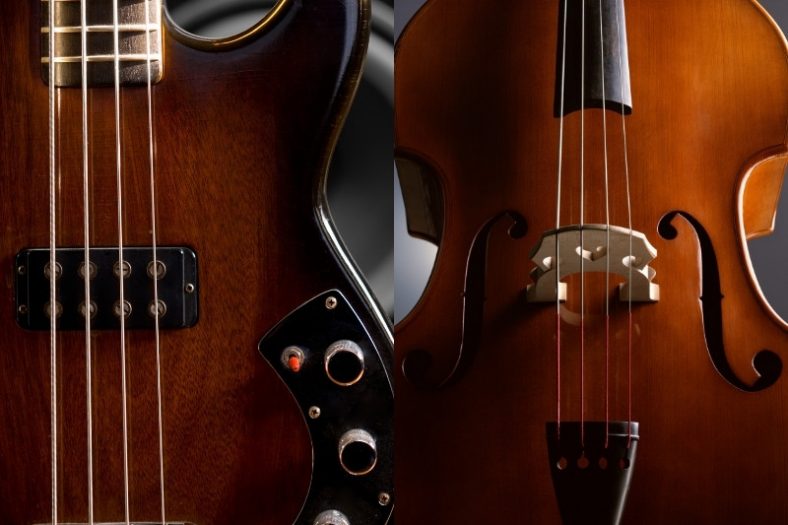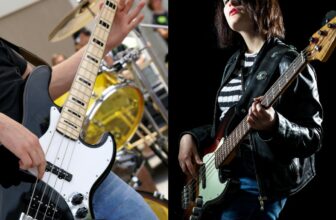The Differences Between Bass and Double Bass

The difference between a bass and a double bass is, firstly, the size. Bass guitars are smaller and are commonly used with a bass amplifier. They are played using fingers or sometimes with a pick, whereas the double bass can be played with fingers or a bow.
Despite being in the same family of instruments, they do have differences between them. Some of which are fairly obvious when looking at them.
Contents
Size and Position
There are a few differences between the two. The first difference is the size. The double bass is considered the largest stringed instrument and is famously known for producing the lowest pitch and the fact that it’s been used in almost every musical genre, including jazz, rock, country, and others.
The bass guitar comes with a fairly smaller size compared to the double bass. It’s usually strapped around the bass player so it can be played while standing or you can even choose to sit down and have it reside on your lap.
The double bass, however, is stood upright because it’s much larger and can also be played using the bow, whereas the bass guitar is played with a pick or using your fingers.
Shape and Hardware
They also have different shapes. The double bass almost resembles a giant violin in a way, whereas the standard bass guitar is more of an enlarged version of a regular guitar.
The main difference is in their hardware. The double bass uses something called a “Soundbox” which emanates and amplifies low frequencies when the strings are played. The bass, on the other hand, uses a pickup. This is essentially a modern version of a soundbox that the double bass uses.
Strings and Sound
They also use different strings. The double bass uses flat wound strings that are specifically designed for this instrument, whereas a standard bass guitar can choose from a variety of different strings that best suit the preference of the player.
It ultimately results in differences in sound. The double bass produces a more low and flat bass sound, whereas the modern bass guitar gives more of a punch when it comes to low frequencies and sounds more put together.
The double bass was added to musical performances as an accompanying instrument to the cello. It essentially doubles the octave of a cello, whereas the standard bass guitar is more associated with doubling the octave of a regular guitar.
They both serve the same purpose but for different instruments which are, to lay the foundation with low-end frequencies that are needed in a certain piece.
How They’re Played
The double bass, being the larger of the two instruments, needs to be held upright next to the player which holds it by the neck with one hand and the other hand on the strings.
Its style of playing sometimes requires a bow or simply plucking the strings with your fingers. The bow is used to rub against the strings in order to produce the sound much like a violin only way bigger.
A standard bass guitar, on the other hand, can be placed on your lap and played while sitting down while it resides horizontally, or using straps so you can stand up and carry it around your shoulders while also holding it by the neck with one hand and the other hand being on the strings.
When it comes to the difficulty of playability between the two instruments, the double bass is considered more difficult to hold, hence, more difficult to play.
Can You Play Both?
Knowing how to play one instrument can certainly help in learning how to play the other. The main difference is that the double bass doesn’t have any frets, so that can be confusing for a lot of standard bass players at first.
They are, however, tuned the same, so that would be a massive help in trying to learn one or the other.
It is considered easier for double bass players to transition to standard bass because the double bass is considered harder to play than the standard bass guitar so the transition will go more smoothly.
A standard bass player would have a few difficulties transitioning to double bass. It will take a while to get used to the positioning of the double bass because most bass players strap their bass guitar around their shoulders and are easy to carry, whereas, the positioning of the double bass requires more discipline.
Their History
The double bass originated in Europe in the 15th century as a descendant of the viola da gamba family and was called a bass viola. As instruments of the viol family were known to have five or six strings and those of the violin family have four, the double bass was with three strings.
Most notably, it was tuned the same as viola da gambas. Its first use in an ensemble was as an accompanying instrument to the cello as they were written in the same musical clef. The only difference was, the double bass was an octave below the cello.
The standard bass guitar came way down the line. The first-ever electric bass guitar was invented in the 1930s as a smaller version of the double bass that was meant to be played horizontally. Its mass production came at the hands of Leo Fender and George Fullerton in the 1950s. It quickly rose to the instrument that we know today.
Summary
Double Bass and the standard bass differ in a few ways. They come in different sizes as well as their differences in positioning. They have different shapes and also don’t have the same hardware. The double bass has a soundbox and a standard bass guitar has a pickup.
They use different strings which ultimately results in a different sound. The double bass provides a more low-end frequency sound, whereas the standard bass guitar has a bit more punch.
They’re played in different ways as well. The double bass requires an upright position and is considered harder to hold and play because it sometimes requires a bow or plucking the strings with your fingers. The bass guitar, however, being much smaller in size, can be carried around the shoulders using straps as it dangles horizontally, which in turn is easier to play and carry.
A double bass player can certainly transition on to a standard bass with relative ease, whereas a bass player might have some difficulties transitioning on to the double bass because of the size difference and the fact that it doesn’t have any frets.





